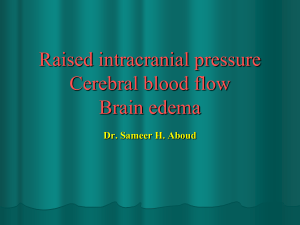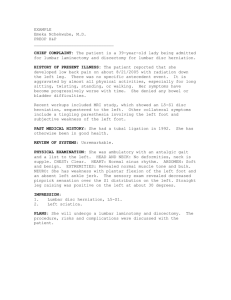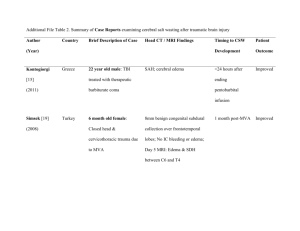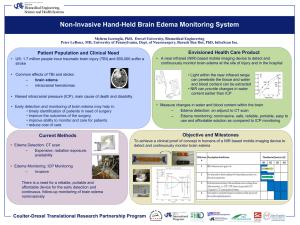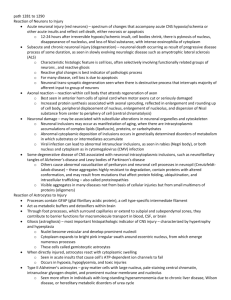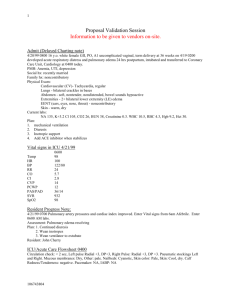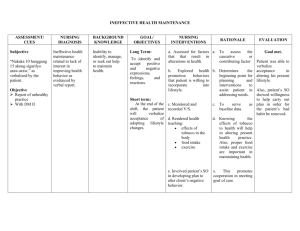brain edema, hydrocephalus and herniation
advertisement
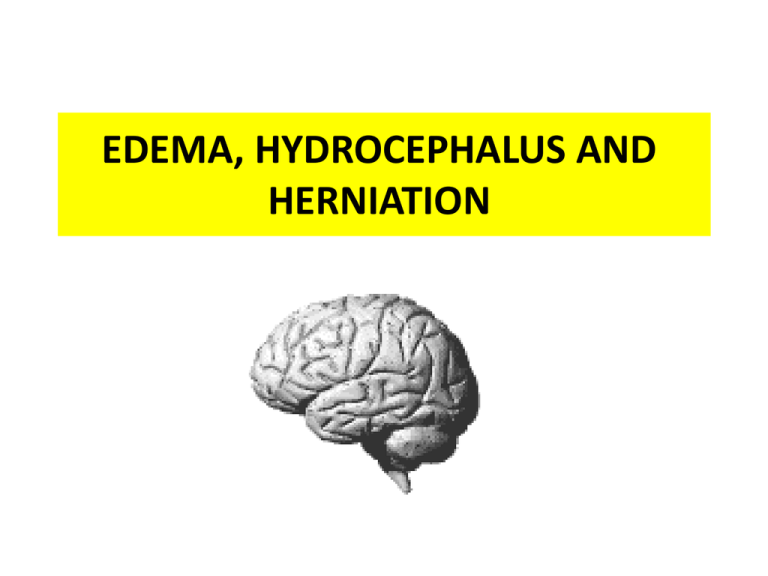
EDEMA, HYDROCEPHALUS AND HERNIATION EDEMA, HYDROCEPHALUS AND HERNIATION • a) Define and differentiate • b) Discuss the causes • c) Compare and contrast different types • d) Explain the pathophysiology • e) Discuss the morphologic features of cerebral edema • f) Discuss clinical manifestations Brain edema, hydrocephalus, Herniation - CSF Circulation (production, flow, resorption) - Increase in intracranial pressure ICP - Anatomical limitation structure (Rigid container) - Treatable - Intra cranial compartment volume =(CSF volume+blood+ brain). CSF ↔ Blood ↔ Brain tissue - Causes; 1. Generalized brain edema. 2. Focally expanding mass lesions- tumor, aneurysm bleeding , etc…………………………… Cerebral Edema 1- Definition: is the accumulation of excess fluid within the brain intercellular& intracellular spaces, in the paucity of lymphatic vessels and may lead to increased intracranial pressure. 2- Causes 1- Traumatic causes- Physical injury. 2- Non-traumatic causes a. Inflammation(meningitis, encephalitis ) . b. Ischemic Stroke. c. Tumor d. Toxins exposure. Cerebral Edema 3-Explain the pathophysiology: Two underlying mechanisms (often occur together): 1- Vasogenic Mechanism: (Extracellular Edema) 2- Cytotoxic Mechanism (Intracellular Edema) 1- Extracellular Edema- Vasogenic mechanism due to disruption of the integrity of the Endothelial cell (blood-brain barrier BBB), on effect of (vasoactive, free radicals, destructive material). - With increased vascular permeability, fluid shifts from the vessels into the extracellular spaces of the brain, can be either: a)localized b)Generalized. - Causes –Acute inflammation (e.g., meningitis, encephalitis) –Metastasis, trauma, lead poisoning. –Fast travel to high altitude without proper acclimatization 2- Intracellular Edema -Cytotoxic mechanism : - Water moves into cells (Cytotoxic): e.g. hypoxic cell injury increase permeability of cell membrane (neuronal, glial and endothelial cells membrane injury ). - The BBB remains intact - Caused by: 1- Generalized hypoxic/ischemic insult Dysfunctional Na+/K+-ATPase pump retention of Na&H2oosmotic shift 2- Exposure to some toxins. 3- metabolic damage. In practice, conditions a\w generalized edema often have elements of both vasogenic ,cytotoxic edema. Cerebral edema 4- Morphology: - The edematous brain is softer than normal appears to "overfill" the cranial vault. - In generalized edema the gyri are flattened, the intervening sulci are narrowed. - The ventricular cavities are compressed. Cerebral edema: The surfaces of the gyri are widened& flattened, the sulci are narrowed -Cerebral edema- CF 5- Clinical manifestations: Symptoms – signs of ↑↑ ICP - Nausea, vomiting, blurred vision, faintness., headache - Severe cases- disorientation, seizures and coma. Clinical consequences: a.- Intracranial compartmental shifts ↑↑Intracranial pressure Compression of vital brain structures.+ ventricular cavity compression. c. Herniation Respiratory arrest b- Cerebral ischemia compromised blood flow. Treatment: - Osmotherapy using mannitol, diuretics - corticosteroids, surgical decompression . Hydrocephalus Definition: is abnormal excessive accumulation of CSFwithin ventricular system & subarachnoid spaces Abnormal dilatation This dilation causes potentially harmful pressure on the tissues of the brain Brain CT scan - Hydrocephalous Dilated ventricles 2-What is the pathogenesis of Hydrocephalous? - Hydrocephalus results from an imbalance between the (CSF) inflow and outflow. 1. Decreased resorption of the CSF- e.g (scarring of arachnoid granulation). 2. Overproduction of CSF- e.g. (choroid plexus tumor , hypertrophy). 3. Impaired flow- e.g. (Stenosis of the cerebral aqueduct, Obstruction of the interventricular foramina - secondary tumor, Hemorrhage) Hydrocephalus (infancy) < fusion of the cranial sutures hydrocephalus occurs acutely or occurs > fusion of the cranial sutures Periventricular brain edema and ischemia leading to atrophy of the white matter. )Progressive ventricular dilatation disrupt ependmya) Hydrocephalus - Etiology - Related condition to the Hydrocephlus: a- Congenital Hydrocephalus ( at birth ): 1 - Neural tube defect: spina bifida, encephalocele . 2 - CNS malformations: Dandy-Walker, Chiari syndrome 3- Choroid plexus papilloma or carcinoma 4 - Intrauterine infection: Rubella, Toxoplasmosis, CMV 5- X-linked type hydrocephalus (genetic defect) b- Acquired Hydrocephalus 1- CNS infections: meningitis, Viral infection. 2- Brain tumors: medulloblastomas, astrocytomas. 3- Post-hemorrhagic: trauma, AV malformation, Aneurysm Hydrocephalus - types - two types: 1- Obstructive (noncommunicating) 2- Non-obstructive (communicating). Both forms can be either congenital or acquired. Hydrocephalus – types 1-Communicating, non-obstructive:LESS COMMON • Non-obstructive = Open communication between ventricles and subarachnoid space, a\w enlargement of all of the ventricular system , caused by: 1.Increased CSF production e.g Choroid plexus papilloma 2.Impaired CSF resorption by arachnoid granulations e.g arachnoid granulations (scarring- meningitis) • Main predisposing factors: 1- Subarachnoidal hemorrhage, 2- Infection, Tuberculous, Pneumococcal infections 3- Congenital absence of arachnoids villi. 1. Meningitis. 2. Subarachnoid hemorrhage • Overproduction of CSF (choroid plexus tumor) Communicating Hydrocephalous. Hydrocephalus - types 2-Noncommunicating (obstructive): COMMON Caused by a CSF-flow obstruction from flowing into the subarachnoid space (either due to external compression or intraventricular mass lesions)+ a\w enlargement of a portion of the ventricles Causes: 1- Aqueductal stenosis\ stricture. 2- Tumor of 4th ventricle e.g. Ependymoma, Medulloblastoma. 3- Malformations of posterior fossa. 4- Fourth ventricle obstruction “chiari syndrome” 5- The foramina of Luschka and foramen of Magendie may be obstructed “Dandy-Walker syndrome” Non communicating Hydrocephalous (Obstructive) Medulloblastoma, Ependymoma Chiari Dandy-Walker malformation Hydrocephalus – clinical features - Vary with Age, duration= disease progression, Site of obstruction and .- CF depend on dilatation of the ventricles and ICP - 1- Rapid increase in head circumference (Newborn) -2-Headache followed by vomiting, nausea. -3- Eye: papilledema. deviation of the eyes-Sun-setting (midbrain pressure) , CN Compression of the 3rd , 6th - Diplopia -4- Balance, poor coordination, Gait disturbance& -Urinary, fecal incontinence (Stretching of sacral motor fibers near dilated ventricle). -6- Slowing or loss of development , 7- Mental retard , memory. 8- Behavioral change(unsceratin) 9- Dementia (limbic fibers pressure) Hydrocephalus : dilated ventricles , Dysjunction of sutures, Tense fontanelle, etc… Head enlargement, Setting-sun sign Brain Herniation 1- Definition: Is displacement of brain tissue from one compartment (separated by dural boundaries) to another, squeezed across structures within the skull, secondary to increased intracranial volume = (brain, blood, CSF) - It is a medical emergency, needed urgent intervention. - Increases compartmental volume 2- Causes of volume increase: 1- tumors & trauma Local edema 2- hemorrhage (subdural) blood clot formation. 3- infections abscess formation Herniation- can occur in absence of Increase ICP Causes- mass S 1. blood clot 2. Tumor 3. Edema 4. Abscess T 5. Trauma 3- The usual clinical consequence of displacement a- Compression of blood supply resulting in infarction b- Compression of other structures& (parenchyma, cranial nerves, ventricle). 4- Herniation are named either by 1- Part of the brain that is displaced . 2- The structure across which it moves. Supratentorial herniation 1- Uncal (transtentorial) 2- Central 3- Cingulate (subfalcine) 4- Transcalvarial Infratentorial herniation 5- Upward (upward cerebellar or upward transtentorial) 6- Tonsillar (downward cerebellar) Causes 1- Subfalcine Hern. 2-Transtentorial Hern. 3- Tonsillar Herniation T Types of Herniation: 1- Subfalcine Herniation (cingulate) 2-Transtentorial Herniation (uncal) 3- Tonsillar Herniation I- Subfalcine (cingulate) Herniation:Mass in cerebral hemisphere forces brain tissue under falx to opposite side ( cingulat gyri is a part of frontal brain lobe) This may be associated with: A. Compression of branches of the anterior cerebral Artery.-lead to:- a. Gait problem b. headach, contralateral weak- B. Effacement of ant. horn of the lateral ventricle- Patterns of brain herniation: subfalcine (cingulate), transtentorial (uncinate), and tonsillar. II- Transtentorial (Uncal) herniation: - Supratentorial mass effect forces cerebral structures (uncal) downward through opening of tentorium, may lead to:- 1. Temporal lobe is displaced Cerebellum The third cranial nerve + post ganglionic Parasympathetic is compromised Resulting in pupillary dilation and impairment of ocular movements on the Side of the lesion. 2. The Posterior cerebral artery may also be compressed, resulting ischemic injury to the area supplied by this vessel Infraction of occipital lobe visual field defect - 3. Duret hemorrhages- hemorrhagic infarcted lesions in the midbrain and pons. (branches of the basilar artery are kinked). Duret hemorrhage: midline hemorrhages involving the brainstem at the junction of the pons and midbrain III- Tonsillar herniation: -Posterior fossa mass effect forces cerebellar tonsils downward through the foramen magnum. - This pattern of herniation is life-threatening, because it causes brain stem compression and compromises vital respiratory and cardiac centers in the medulla. Clinical features: •Headache, * Coma • Cardiac arrest. * Loss of reflexes * Respiratory arrest. • Complications: • Death Permanent neurologic deficit Thank you

